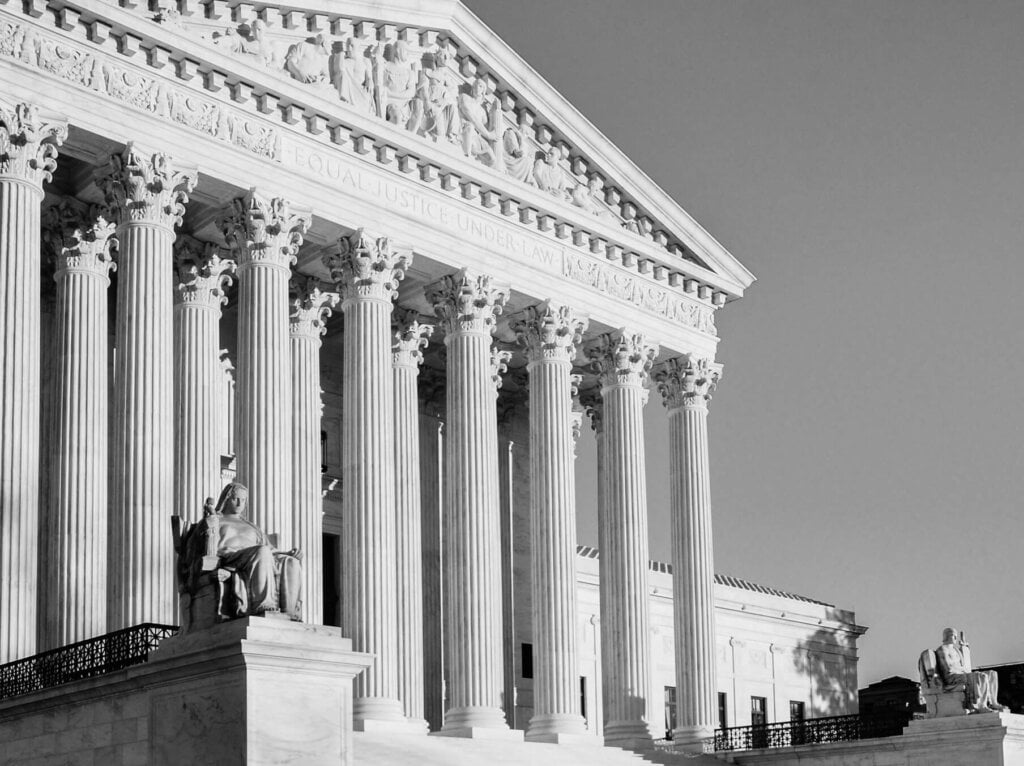In a thoughtful decision recognizing the impacts of the online economy, the Supreme Court of the United States rejected a rule that would find “generic.com” trademarks as per se generic and therefore ineligible for trademark protection. The 8-1 decision written by Justice Ruth Bader Ginsburg on June 30, 2020, opens the door for businesses using “.com” or other top-level Internet domains to secure trademark protection. The decision reflects the evolving intellectual property landscape in response to technology and overall shifts to online commerce, which is accelerating due to the COVID-19 pandemic.
Case Background
Booking.com, a digital travel company offering hotel reservations and other services under the brand and website domain name “Booking.com,” filed four trademark applications for travel-related services that each included “Booking.com.” The United States Patent and Trademark Office (“USPTO”) and Trademark Trial and Appeal Board (“TTAB”) both found “Booking.com” was a generic term because “Booking” simply means making travel reservations, while “.com” is merely a commercial website. According to the USPTO and TTAB, the “Booking.com” term was generic and therefore ineligible for trademark protection.
After seeking review in the U.S. District Court for the Eastern District of Virginia, Booking.com introduced new survey evidence that prompted the district court to find that the consuming public believes that Booking.com “does not refer to a genus, rather it is descriptive of services involving ‘booking’ available at that domain name.” The district court found “Booking.com” is descriptive, not generic, and had acquired secondary meaning in relation to hotel reservation services. Thus, the mark was protectable.
After the USPTO appealed, the Court of Appeals for the Fourth Circuit affirmed and rejected the USPTO’s proposed rule that combining a generic term with “.com” is generic. That decision was appealed to the Supreme Court.
Decision
The Court first set forth “several guiding principles” that served as a backdrop for its opinion. First, generic names, which merely describe the name of a class of goods or services, do not distinguish between different producers’ goods or services and are ineligible for federal trademark registration. Second, for compound terms, “the distinctiveness inquiry trains on the term’s meaning as a whole, not its parts in isolation.” Third, the “relevant meaning of a term is its meaning to consumers.” The Court also emphasized “the Lanham Act’s focus on consumer perception” as a fundamental rationale behind what is protectable under trademark law.
Beginning its thoughtful analysis, the Court noted that consumers do not believe that the “Booking.com” term merely signifies the class of online hotel reservation services. For example, consumers do not consider Travelocity, another online reservation service, a “Booking.com,” nor would consumers search for a “Booking.com” when looking for any online reservation service. Thus, the Court concluded that “[b]ecause ‘Booking.com’ is not a generic name to consumers, it is not generic.”
The Court next addressed the USPTO’s proposed rule that a generic term combined with a generic top-level domain (e.g., “.com”) is essentially always generic and ineligible for trademark protection. Citing “ART.COM” and “DATING.COM,” which are both federally registered marks, the Court observed that the USPTO’s “own past practice appears to reflect no such comprehensive rule,” and that imposing such a rule now could threaten to cancel existing marks. The Court also found “no support for the PTO’s current view in trademark law or policy.”
The USPTO attempted to invoke pre-Lanham Act SCOTUS precedent in Goodyear’s India Rubber Glove Mfg. Co. v. Goodyear Rubber Co., 128 U.S. 598 (1888), which held that a generic corporate designation added to a generic term does not protect an otherwise unprotectable, generic term. Describing this argument as “faulty”, the Court noted that “generic.com” terms “might also convey to consumers a source-identifying characteristic: an association with a particular website.” Notably, only one entity can occupy a specific domain name at any given time, supporting the fundamental trademark policy of identifying sources of goods or services. The Court found further reason to reject the per se rule after reiterating that the “bedrock principle of the Lanham Act is incompatible with an unyielding legal rule that entirely disregards consumer perception.” True to the fundamental policies underlying trademark law, the Court held that bright-line rules either prohibiting or automatically allowing “generic.com” terms are inappropriate and that the inquiry is “whether consumers in fact perceive that term as the name of a class, or instead, as a term capable of distinguishing among members of the class.” While survey data, similar to what Booking.com presented to the district court, may help answer that question, Justice Sotomayor’s concurring opinion noted that surveys are only one possible source, in addition to “dictionaries, usage by consumers and competitors, and any other source of evidence bearing on how consumers perceive a terms’ meaning.”
The USPTO and Justice Breyer’s dissent expressed concerns that affording “generic.com” trademark protection would hinder competitors and support monopolistic behaviors. However, the Court stated that these concerns, which are implicated in any descriptive mark, are adequately addressed by other trademark policies such as infringement, likelihood of confusion, and “crowded field” analyses, as well as the classic fair use doctrine. The strength or viability of a “generic.com” mark is separate from whether such a term may be entitled to federal trademark registration at all. The Court also noted that other doctrines such as unfair competition are not substitutes for the greater protection afforded to federally registered trademarks. Thus, the Court found “no cause to deny Booking.com the same benefits Congress accorded other marks qualifying as non-generic,” and affirmed the Fourth Circuit.
Implications
The Court’s well-reasoned opinion adheres to fundamental trademark principles while recognizing how the internet and online marketplaces have changed commercial landscapes. Rejecting the USPTO’s proposed per se rule affords businesses (largely online ones) using “generic.com” terms the same opportunities for securing trademark protection for their marks. The Court’s rejection of a bright-line rule automatically prohibiting or allowing such marks highlights the importance of consumer perception in ascertaining whether or not a term is protectable.
Further, this decision provides a measure of clarity for potential applicants who can gather anticipatory evidence through surveys, term usage, or other sources to demonstrate the terms are non-generic, allowing them to better position their trademark applications as well as the strength of their marks in the online economy.
Finally, while this decision would be significant in any time due to the internet economy’s continuing growth, it may be especially timely given increases in online commerce due to the COVID-19 pandemic. This decision provides greater clarity for businesses seeking to establish or increase their online presence, while also providing a framework for parsing what may likely become increasingly crowded fields online.









